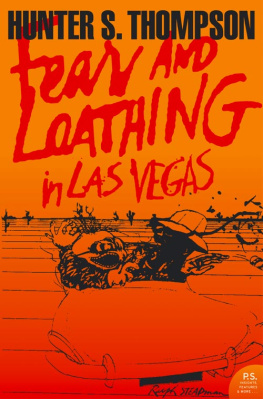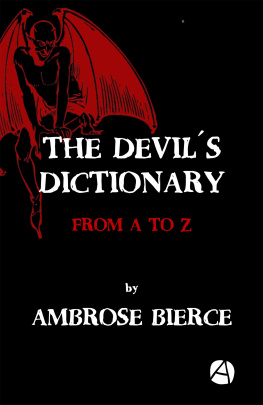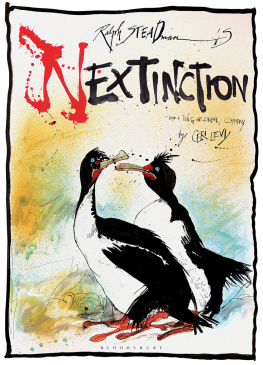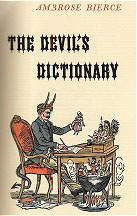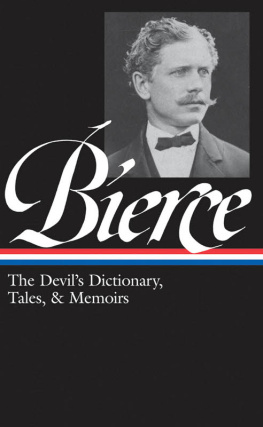THE DEVIL'S DICTIONARY


AMBROSE BIERCE
Illustrated by
RALPH STEADMAN
Introduction by Angus Calder

First published in Great Britain 2003
Copyright Ambrose Bierce
Illustrations and display face (Cheltenham Spa bold)
Copyright 2003 by Ralph Steadman
This electronic edition published 2009 by Bloomsbury Publishing Plc
The right of Ambrose Bierce to be identified as the author of this work has been asserted by him in accordance with the Copyright, Designs and Patents Act 1988
All rights reserved. You may not copy, distribute, transmit, reproduce or otherwise make available this publication (or any part of it) in any form, or by any means (including without limitation electronic, digital, optical, mechanical, photocopying, printing, recording or otherwise), without the prior written permission of the publisher. Any person who does any unauthorised act in relation to this publication may be liable to criminal prosecution and civil claims for damages.
Bloomsbury Publishing Plc, 36 Soho Square, London W1D 3QY
A CIP catalogue record for this book is available from the British Library
eISBN: 978-1-40880-715-6
www.bloomsbury.com/ambrosebierce
Visit www.bloomsbury.com to find out more about our authors and their books. You will find extracts, authors interviews, author events and you can sign up for newsletters to be the first to hear about our latest releases and special offers.
CONTENTS
Angus Calder
Ambrose Bierce (1842-1913?) despised realism. In his Devil's Dictionary he defines it as 'The art of depicting nature as it is seen by toads... or a story written by a measuring worm.' Assuming that his own life was a fiction, who would credit as 'realistic' either its beginning or end the bizarre circumstance of his naming, 'Ambrose Gwynett,' and the extraordinary fact that one of America's most celebrated literary men and public figures could disappear totally without trace on an actual or fabricated excursion into Mexico to view the battles of its revolution?
Rather more mundanely, there is a staring contradiction between the personality projected in his journalistic writings that of a cynical misanthrope and intractable misogynist, despairing of all politicians and their isms, venomously antipathetic to all religious belief and to clerics of every known or conceivable creed, and scathing in his invective against writers, famous and obscure, whom he considered bad and the person exposed by attentive biographers. The atrabilious Bierce persona of the Dictionary was the mask of a much hurt man.
Though he quarrelled with many friends sooner or later, he always had ample to choose from. Perhaps because they thought they knew that his contempt for females was a pose, numerous women were amongst the young writers who flocked for advice to the Dr. Johnson of San Francisco, the literary arbiter of West Coast America, and to whom he was unflaggingly kind and supportive. 'Bitter Bierce', 'The Wickedest Man in San Francisco,' somehow survived, with a rich sunset glow of reputation, a long journalistic career in which he raked with wit and sarcasm which resounded across America and then over the Atlantic, fellow writers as famous as Henry James and Stephen Crane, all Freemasons, exorbitantly wealthy capitalists, several Presidents and also obscure preachers, grafting local officials and feeble poetasters.
We cannot recapture whatever charm it was in Bierce madecontemporaries tolerate, relish and even love the great'curmudgeon.' Suffice it to point out, as brief accounts of hislife tend not to, that he was an extraordinarily handsome man.He was tall and stood very straight, fit-seeming, though he hadchronic asthma. His fair hair flourished, his moustache wasmagnificent. His eyes were clear blue and his complexion freshand rosy despite his habitual excesses with strong drink. Hedressed very stylishly indeed and was obsessively committedto personal hygiene, perhaps because he had spent the formativeyears of his life in the stench and filth of one of thenastiest conflicts in human history.
He was born on 24 June 1842, in Meigs County, Ohio.He was the tenth child of Laura and Marcus 'Aurelius' Bierce.Father, an indigent farmer and devout Congregationalistpuritan, descended, like Mother, from seventeenth-centurysettlers in New England, decided that each child's name shouldbegin with A Abigail, Amelia, Ann, Addison, Aurelius,Augustus, Almeda, Andrew, Albert then Ambrose. But howhad Marcus come by the melodramatic play by the Englishwriter Jerrold Ambrose Gwynett; or A Seaside Story (1828),which gave him a G to go with the infant's A?
Further As followed Arthur who died in 1846 aged ninemonths, then twin girls, Adelia and Aurelia, both dead withintwo years. Understanding of Ambrose surely has to begin withthe fact that as his own understanding dawned, his motherwas preoccupied firstly with caring for infants, secondly withmourning successive losses. Woman did not give Boy the lovehe needed. Rejecting Parents and Family, he took to books.Marcus was said to have the largest library in KosciuskoCounty, Indiana, where the family moved in 1846. Here Boybrowsed.
Ambrose was a loner, unhappy both at home and school.When he turned fifteen, he quit the homestead for good,at first working as a printer's 'devil' on the Abolitionist newspaperrecently founded in the nearby town of Warsaw.Thence he gravitated to Akron, Ohio, where Marcus's verydifferent younger brother Lucius was the most prominentlocal citizen lawyer, published author, four times mayor,and military legend. In 1838, Canada had seethed with rebellionagainst British rule. 'General' Bierce had led a force of500 volunteers across Lake Erie to stir things up. Now hewas a fierce Abolitionist, who provided arms and ammunitionfor John Brown when the latter set off on his bloodysortie into the proslavery South.
Lucius decided that Ambrose should be a soldier. He senthim, aged seventeen, to the celebrated Kentucky MilitaryInstitute. Ambrose dropped out after only one year, butacquired a military bearing and skills in design and cartographywhich quite soon became very useful indeed. For ninemonths, Ambrose drifted through menial jobs in Warsaw.Then in the spring of 1861, Civil War erupted. Bierce wasone of the first to enlist in Lincoln's army.
With the Ninth Indiana Volunteer Infantry Regiment,Bierce entered diurnal trauma. Twenty thousand British soldiershad died in the recent Crimean War, only 3,000 directly incombat. In the appalling Battle of Shiloh in April 1862, inwhich Bierce took part, there were 23,741 casualties. All hisservice was in the South. For a son of the flat Midwest, themountainous terrain was breathtaking. Its beauty, withagonizing irony, was backdrop to scenes of futile heroism,nightmare butchery. Bierce saw hogs feeding on the corpsesof dead soldiers, brains oozing out of shattered skulls. In asense he had a 'good war'. His extreme bravery attracted attentionearly on, when he rescued a wounded comrade underConfederate fire. His Kentucky Institute year further markedhim for promotion. In February 1862, already a sergeant, hewas reassigned to General William B. Hazen's brigade inBuell's Army of the Ohio, and named topographical officer,surveying terrain. In a year, he rose to first lieutenant. ByNovember 1864 he was brevet captain. Close to Staff, heobserved with disgust the behavior of generals, some silly,others callous. His hero was Hazen, who suffered no follygladly, whether in infantrymen or senior commanders.
Next page

